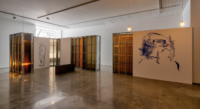Curbside recycling meeting objectives
By Jensen, Randy on June 25, 2020.
 The City says that a year after launch of the curbside recycling program and the Material Recovery Facility they are meeting objectives in reducing landfill waste and selling recyclables successfully in the North American marketplace. Herald photo by Ian Martens @IMartensHerald
The City says that a year after launch of the curbside recycling program and the Material Recovery Facility they are meeting objectives in reducing landfill waste and selling recyclables successfully in the North American marketplace. Herald photo by Ian Martens @IMartensHeraldTim Kalinowski
Lethbridge Herald
tkalinowski@lethbridgeherald.com
One year after implementation, the curbside recycling program and the Material Recovery Facility (MRF) are meeting their objectives in reducing landfill waste and selling locally produced recyclables successfully in the North American marketplace.
“It’s been over a year for the curbside recycling program, and we’re pretty happy with the results so far,” reported City Waste and Recycling Services general manager Joel Sanchez at Monday’s Community Issues Committee meeting. “Participation from residents has been about 65 per cent, which is a good number. And we really want to see that number going up, but it will come with the maturity (of the program). In addition to that, we did a waste audit where we looked at the black waste carts one more time after implementation, and we still notice there are about 10 per cent of recyclable materials in the black cart. Again, that’s normal. With growth and maturity in the next year or two, we want to make sure we can capture the majority of that 10 per cent.
“On that marketing side,” he added, “we have also had really good results. With the contractor we have there (at the MRF) and with our commodity market broker we have, they have been able to move all the materials. Not only for the blue cart, but also from the recycling depots.”
Overall between the blue carts and the recycling depots Lethbridge residents are doing well in keeping most contaminants out of the recycling which allows for a very clean and easily moveable product, said Sanchez, with only about 10 per cent waste in all materials taken in for recycling.
Sanchez said the City is proceeding with the next stages of the project in bringing multi-family dwellings into the program.
However, there has been some pushback from some property managers, admitted Sanchez.
“After city-wide implementation for single family, we started last year with the multi-family sector,” he explained. “What we did was divide those into two groups: those that have less than 45 units; and those that have more than 45 units. The idea was to work with the smaller groups first to be able to implement. We are probably at about 45-50 per cent of the multi-family (rolled out) right now. We have a group of large condos in the city that want to get a different approach for recycling. They are not happy with the cost of $7 per month per household. They believe that should be lower. We have been working with them to explain why the cost is $7.”
Sanchez also explained to councillors that in reality single-family households are actually paying $9 per month, with $2 being transferred over to the garbage side of things to absorb the cost there. Multi-family dwellings would only pay $7 straight up, a lower price than what others pay, he said.
“So a single family in reality is paying $9 for recycling collection, and multi-family is only going to be $7; so they will be cheaper than a single-family household pays,” Sanchez confirmed.
Sanchez also announced on Monday the blue cart “Oops Tagging” program will recommence in September with inspectors looking at all carts at households to ensure only proper materials are being put in.
“We visited every single household at least four times in the year, and they go and open the bin to check if there are contaminants,” he explained. “If there are contaminants, they put a tag and the cart is turned around and we don’t pick it up. The idea is to tell residents why we didn’t; say, if you have glass or plastic bags.”
On the subject of plastic bags, Sanchez said the City is still exploring marketing options for the material which can only be recycled at the depots and not in blue carts. But, he said, they had less than one truckload of the material sitting in storage after it was processed and condensed. And 70 per cent of crushed and stored glass, also not allowed in blue carts, Sanchez explained, would be used up for trail resurfacing material here in the city by this October.
Sanchez also said he hoped to put in an amended proposal for moving forward on organics recycling before council by next spring’s Capital Improvement Program discussions.
“We are currently refining the plan we proposed last October,” he said, “and are looking at different options we can improve in order to come back to city council in the spring of 2021. If they do approve it at that time most likely the program will go to pilot in 2022, and be released city-wide in 2023. But again, that all depends on what decisions are made at CIP time.”
Follow @TimKalHerald on Twitter
20-19




